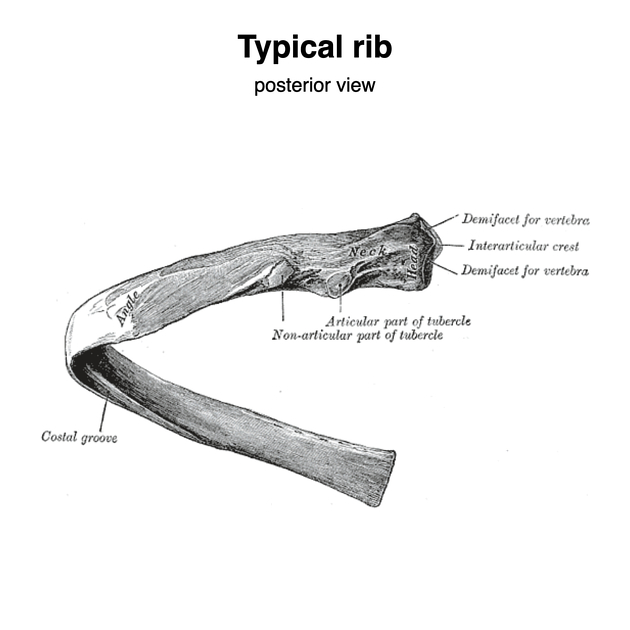Typical ribs are those numbered 2 to 10 with ribs 1, 11 and 12 considered atypical. Some authors however include ribs 2 and 10 also atypical.
On this page:
Gross anatomy
A typical rib is long and flat. They contain a:
- head
- neck
- tubercle
- shaft
- angle
Ribs have a rounded, smooth superior border. The inferior border is thin and sharp.
Osteology
Head
The head of a rib has two facets for the vertebral body above and below, which are separated by the crest of the head, which itself attaches to the intervertebral disc of the vertebrae above.
Neck
The neck is the narrow portion of the rib, between the head and tubercle.
Tubercle
The tubercle, immediately after the neck, is a prominence on the external surface of the rib which contains a medial facet that articulates with the transverse process of the numerically corresponding vertebra. This area is called the articular part. The non-articular part provides attachment for the lateral costotransverse ligament.
Shaft (or body)
The lengthy shaft follows the tubercle. It is thin, flat and twisted on the long axis. The shaft bends anteriorly at the angle of the rib. The angle marks the lateral limit of the attachment of the deep back muscles to the ribs.
Costal groove
The inferior border contains a groove called the costal groove. The costal groove protects the neurovascular bundle, in order from superior to inferior the intercostal vein, artery and nerve (mnemonic: VAN).
Articulations
Vertebrae
The rib heads articulate with vertebra by two facets - the costovertebral joints. The superior facet articulates with the vertebra above. The inferior facet articulates with the numerically corresponding vertebral body below.
The joint capsule is reinforced by the radiate ligament. This ligament has three bands. The upper band extends to the body of the vertebra above. The lower band extends to the vertebra below. The central band runs horizontally, deep to the anterior longitudinal ligament, into the intervertebral disc.
The tubercle articulates with the transverse process also by means of a synovial joint - the costotransverse joint.
Costochondral joint
Every rib articulates with costal cartilage with a primary cartilaginous joint.
Sternocostal and interchondral joints
Costal cartilages 2 to 7 articulate by their own synovial joints to the lateral border of the sternum.
Ribs 6 to 10 articulate with costal cartilages which then articulate with each other along their borders through small synovial joints.
Attachments
There are a number of muscles related to typical ribs.
- the intercostal muscles are situated in the intercostal spaces. there are three main groups running superficial to deep:
- the diaphragm rises from the inner surfaces of the costal cartilages on the sixth rib
- the serratus anterior muscles originate anterolaterally from ribs 1 to 8
- the pectoralis major and minor muscles arise from superior anterior ribs
- the latissimus dorsi has origins in the 9th to 12th ribs
- scalenus anterior, posterior and medius muscles have attachments in the first and second ribs
- the rectus abdominis inserts at the xiphisternum and 5th to 7th costal cartilages
Arterial supply
- anteriorly: branches of the internal thoracic artery or musculophrenic artery
- posteriorly: intercostal arteries
Venous drainage
- into corresponding intercostal veins
Innervation
- Innervated segmentally from branches of the corresponding intercostal nerves
Radiographic features
On frontal chest radiographs, 12 pairs of symmetric ribs should be visible. Typical ribs specifically demonstrate a flanged inferior cortex where the costal groove runs.






 Unable to process the form. Check for errors and try again.
Unable to process the form. Check for errors and try again.